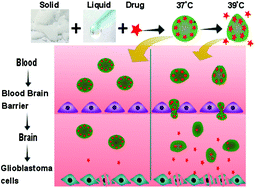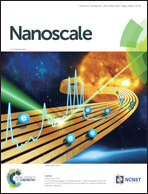Enhanced blood brain barrier permeability and glioblastoma cell targeting via thermoresponsive lipid nanoparticles†
Abstract
Thermoresponsive targeting is used to deliver therapeutic agents at hyperthermic conditions (39–45 °C). However, available thermoresponsive drug delivery systems (TDDS), including liposomes, have a complex method of preparation involving toxic solvents and reagents. The objective of this in vitro study was to prepare and characterize thermoresponsive lipid nanoparticles (TLN) for treating glioblastoma, the most aggressive brain tumor whose treatment is limited by a low blood brain barrier (BBB) permeability of drugs. Thermoresponsive lipids were prepared by mixing liquid and solid fatty acids (0.1 : 1 to 2 : 1 ratio) and lipid mixtures exhibiting a solid–liquid phase transition at 39 °C were identified by plotting melting point against liquid contents. TLN were prepared by a hot melt encapsulation method using mono- or double-surfactant systems. TLN showed desirable size (<270 nm), zeta potential (−35 to −50 mV), spherical morphology and stability by FTIR studies. In the drug release studies, paclitaxel release was slow at 37 °C, however, it was released abruptly at 39 °C due to the faster diffusion rate from liquid state nanoparticles. During cytotoxicity studies, the unloaded TLN were non-toxic whereas paclitaxel loaded TLN showed higher cytotoxicity to glioblastoma cells at 39 °C (69% cell viability after one hour) compared to 37 °C (82% cell viability). The TLN showed higher permeability across an in vitro model of BBB at 39 °C due to a deformable liquid state which can squeeze through the tight junctions of the BBB. In conclusion, this study demonstrated that the TLN can be used as a safe and effective alternative to traditional TDDS with higher potential to target glioblastoma cells across the BBB.



 Please wait while we load your content...
Please wait while we load your content...